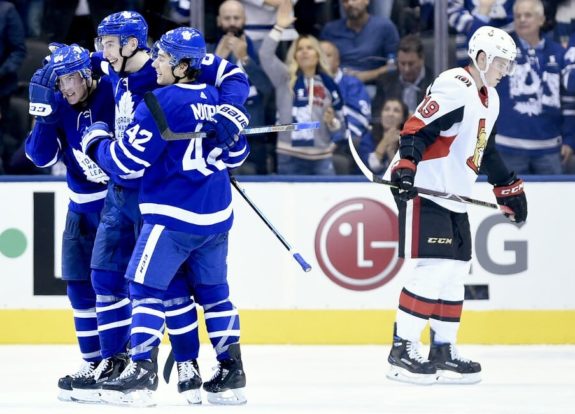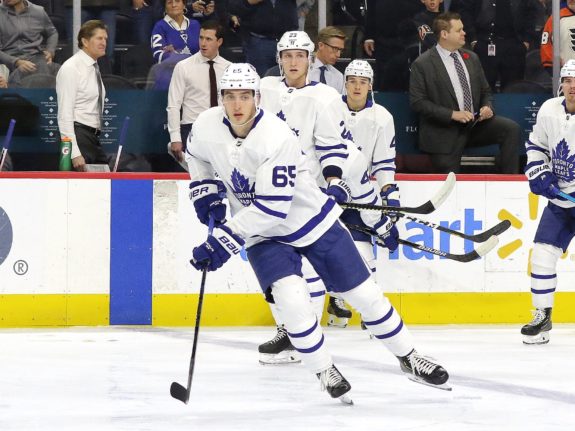Just over a week ago, I wrote a post titled “Maple Leafs Should Consider Trading Ilya Mikheyev.” In that post I suggested that (a) if the Toronto Maple Leafs didn’t have Mikheyev in their long-term plans they should consider trading him and (b) that, over the past season, he’s had a difficult time scoring since his wrist injury. However, I also suggested the possibility that Mikheyev could have a breakout season in 2021-22.
Related: Toronto Maple Leafs Need to Sign Ilya Mikheyev Long-Term
In that post I cited Sportsnet’s Justin Bourne’s article last season that suggested Mikheyev had “been handed a damn tough assignment this season (which in itself shows the team trusts him) and (has) done fine with it.”
In his article, Bourne noted that Mikheyev had “been handed a lot and is mostly losing the statistical battle in those minutes, but someone’s gotta muck the barn so the farm can run smooth.”

Readers comments made us (Stan and I) go back and take a look at what Bourne reported as a lost statistical battle. The results of our research suggests that, while we agree with much of what Bourne said in his article, it isn’t exactly true that Mikheyev is “mostly losing the statistical battle.” In this post, we’ll suggest that Bourne is incorrect and that his analysis only holds true in the area of shot attempts. We’ll also suggest what the Maple Leafs might do with Mikheyev moving into the future.
The Analytics Show a Pattern of Mikheyev’s Progression
It’s true that Mikheyev’s Corsi (shot attempt differential while playing at even strength) last season was slightly in the negative; however, if you look at his other numbers, there’s an interesting pattern of progression.
| Analytic Used | Percentage |
| Corsi For | 48.90 percent |
| Fenwick For | 49.83 percent |
| Shots For | 51.18 percent |
| Scoring Chances For | 52.51 percent |
| High Danger Chances For | 57.33 percent |
Remembering that any number above 50 percent is positive, when Mikhehev’s body of work over the past season is considered he’s mostly positive.
Specifically, looking at more than just Corsi, we see that Fenwick (blocked shots) is close to even. However, Mikheyev’s numbers move into the positive for Shots and Scoring Chances, and then show an even great percentage for creating High Danger Chances. What’s more interesting is that he is – as Bourne suggests – given difficult assignments and started 65% of his shifts in his own zone.
Looking at Mikheyev’s Play During the Playoffs
The analytics we used are all regular-season statistics. Bourne’s article was written prior to the playoffs and his analysis was based upon what he saw during the regular season. However, given what all Maple Leafs’ fans know was a team struggling (and eventually losing) during the 2020-21 playoffs, for this team to find success it needs solid playoff performers. Given that need, how did Mikheyev perform analytically during the playoffs?
Related: The Best Nicknames in Hockey
First, Mikheyev’s time on ice during the playoffs mirrored his regular-season time on the ice. However, his starts were a little more balanced. During the playoffs, he “only” started 57% of his shifts in the defensive zone.
Using the same stats as above here is how he looked.
| Analytic Used | Percentage |
| Corsi For | 55.71 percent |
| Fenwick For | 58.72 percent |
| Shots For | 58.82 percent |
| Scoring Chances For | 61.67 percent |
| High Danger Chances For | 61.11 percent |
Mikheyev’s playoff statistics are really quite amazing; and, they are exactly what the Maple Leafs need if they ever hope to move past the first round of the playoffs.
Mikheyev’s Shooting Percentage Could Improve, For Sure
As for Mikeheyev’s poor shooting percentage, all shots are not equal. In many cases, when a player has a lower shooting percentage he’ll generate shots but not high-danger scoring chances. That’s not the case with Mikheyev. He generates both scoring chances and high-danger chances.
There’s an old-school hockey saying many coaches repeat. It goes something like: “If a player is getting his chances, sooner or later they will start going in.”
In addition, one interesting thing about sports in general is that streaks encourage confidence that increase success. Hockey is sometimes as much a mental as a physical game. Our suspicion is that, once Mikheyev scores a few goals over a short period of time, he’ll gain more confidence in his shot. That added confidence will lead to more goals, which will generate more confidence, which will act to start a positive cycle of success.
Or not.
What if Mikheyev Is Exactly What We’ve Seen?
As I suggested in my last post about Mikheyev, it’s possible Mikheyev is exactly what he is now. Offensively, he might stay a 13-15-goal scorer who totals about 35-40 points each season. Still, defensively, he’s big, fast, good defensively, can kill penalties, and gives the Maple Leafs a solid 15 minutes every game.
If that’s Mikheyev’s best case, we’re fine with that.
What to Do with Mikheyev?
Will Mikheyev want more money on his next contract? Of course. If nothing changes that jacks up his offensive numbers, could he still get more money on his next contract? He undoubtedly could. The case in point is teammate Alex Kerfoot.
Related: NWHL Roundup: Neumann Retires, Season 7 Start Date Revealed, 9 Players Signed
Kerfoot makes $3.5 million each season. He’s averaged nine goals and 25 points during each of his two seasons with the Maple Leafs. However, a few things mediate Kerfoot’s salary.

First, Kerfoot was often a top-six player with the Colorado Avalanche and his contract was signed off that potential. He hasn’t often played top-six minutes with the Maple Leafs and his numbers reflect that. Second, Kerfoot is a center, which adds to his value. Third, Kerfoot’s flexible and can fit anywhere the team needs him. Still, in his two seasons with the team, Kerfoot has never scored 10 goals a season, nor has he yet bumped over the 30-point total.
Would Mikheyev Leave Toronto?
Watching Mikheyev, you have to think he likes playing in Toronto. The team’s been good to him. But you also have a sense that he’d like his time anywhere: he’s that kind of guy. Still, he has no ties to the city beyond his two seasons.
If a player with ties to Toronto like Zach Hyman had to leave to earn a higher salary, there’s no reason to believe Mikheyev would be different. If he can get double his contract, he’d likely do so.
Extending a Contract Offer to Mikheyev
Given what we know about Mikheyev, we believe the Maple Leaf should approach him about extending his contract now with an offer of between $2 and $2.5 million and a term of three to five years, without movement clauses. If he’d be willing to sign for that amount and continues to play at the same level he’s playing at now, it would be a good deal for the Maple Leafs.

If Mikheyev did have a career year and became a 15-20 goal-scorer who put up 40-45 points, that’s a bonus. If he signed the deal, but it looked as if he didn’t fit the team’s plans after the 2021-22 season, it should be easy enough to trade him with that contract. In fact, he should bring solid return.
What if Mikheyev Says No to a New Contract?
If Mikheyev says no to such a contract extension and wants to test the free agent market, it’s possible to trade him now. If it’s a deal that adds value to the team, pull the trigger. That deal could be done now, during mid-season, or at the trade deadline.
Related: Toronto Maple Leafs’ Ilya Mikheyev Arbitration Could End Badly
If general manager Kyle Dubas can’t arrange a deal the organization is comfortable with, it’s back to the dreaded “internal rental” idea. Gosh knows we’d like to avoid that scenario.
[Note: I want to thank long-time Maple Leafs’ fan Stan Smith for collaborating with me on this post. Stan’s Facebook profile can be found here.]
